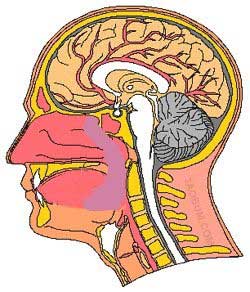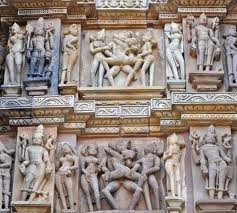Editor’s Note:
In this and the next issue of Sutra Journal, Dr. Stuart Sovatsky continues a discussion on the nature and the impact of the Scientia Sexualis, the
sex-desire-centric ‘liberated sexuality’ based in Freudian theories and supported by modern birth control methods, which has also appropriated Indic Ars
Eroticas of Kundalini-Tantra and Hatha Yoga in Scientia modes of ‘neo-tantra’ and ‘neo-yoga’.
The nature and power of Ars Erotica itself is rooted in a lifelong ‘perineum-to-pineal’ spinal puberty of ‘profound pleasures’, tied to a sacred inner
development, as seen in the ‘liberations’ noted in the Dharma traditions of Indian Kundalini-Tantra and in charismatic ‘being moved’ spiritual traditions.
These two terms were coined by Michel Foucault in his Vol.1, The History of Sexuality as will be further discussed on Dr Sovatsky’s article.
A Brief Point On: ‘All Now’ Ultimacy” and the “Lifelong Ars Erotica Maturation of Seed-forces as Family Lineages, as Inner-Marriage Saints
Numerous spiritual teachers are calling Now-consciousness the ‘ultimate enlightenment’ based in ‘the giving up of all seeking’ and finding Wholeness right
here, right Now. Yet, this fully-attentive, being ‘present’, unchanging or ‘always in the Now’ awareness seems to fit the ars erotica definition
of pratyahara or dharana or, possibly, some glimmers of dhyana - de-sticking one’s ‘bare attention’ from inner and outer
objects, worries or thoughts for longer and longer periods of time; and santosha, acceptance of pain and pleasure equally - but not the
long-esteemed, nir-bija samadhi that involves complete energetic maturation or, literally, ‘full exhaustion’ (nir-) of bija,
‘the seed-forces-of-incarnation’.
For, Awakening to Presence is just the beginning of ars erotica maturations that deepen the physical and energetic complexity of
one’s awakening within the hormones and neurotransmitters (the elixirs) of the body.
Thus, Adi Shankara (788-820 A.D.), the modern Indian founder of Advaita modified his teachings by adding the bhakti of devotional longing
to his life - known as Dvaita-Advaita, dual-toward-nondual path - indicating that there is More (God, Siddhi-Power of Love), beyond one’s
current santosha equanimity. And, not to be ignored, he was an ars erotica, inner-marriage saint.
For, the Indian standard for ‘enlightenment’ has always included a resolution of gender duality expressed as a transcendence of scientia sexualis
desires. But, the modern neo-advaita teachers are, typically, within the scientia spell and skip over the profound limitations within scientia sexualis realm of sex-desire. They teach transcendence of all other ‘seeking and desiring’ - except sex-desire. Celibacy, for a while,
might be recommended as a means to getting some freedom, but not as an ars erotica inner marriage. Indeed, the vast ars erotica, on its
own terms, remains thoroughly hidden from (or by) these ‘neo’ teachings.
My brief review of esteemed Eastern yogic, tantric, Jain, Buddhist, advaitic, bhakti, et al, spiritual figures over the
past 5000 years, yielded a ratio of 515:0 ars erotica lifestyles to scientia sexualis lifestyles. Based upon, arguably, millions of
unnamed participants in thousands of various Kumbha melas (Great Gatherings of saints) over the millenniums, I estimate a ratio of over
one-million to zero.
That this numerically overwhelming historical fact is typically considered inconsequential, psychoanalytically pathological, or not at all, by contemporary
nondual teachers, all levels of yoga teachers and neo-tantra teachers in the contemporary scientia sexualis Transpersonal yogic and tantric discourses is an indication of the profound power of the spell of the scientia sexualis.
Also, for the first time in the history of spirituality, fertility and its consequence of family and the esteemed centrality of lifelong marriage have
become a tangential concern in the contemporary enlightenment discourse. For example, Nisargadatta’s ‘No Self’ teaching is lauded while his lifelong
marriage has, so far, received no inquiry - even among Nondual Marriage and Family Therapists - as to how he accomplished such loving loyalty. He even
renounced all traveling to be at home with his wife and children, something no current spiritual teacher has, so far, done. Priorities may seem like mere
relativities of ‘familial roles’, but existentially as real life choices, they are absolute.
Thus, too, it was only in 2009, after nearly forty years of teaching that family life is a kind of ‘melodrama’ to test one’s actual spiritual growth that
Ram Dass, the coiner in 1970 of the current Be Here Now super-meme, awoke to an error in his teachings on soul love and familial relationships.
Via his suddenly discovered paternity and grand-paternity, he “developed a deeper understanding of the love parents feel for their children and began to
see [for the first time in his adult life?] that personal and soul love are not mutually exclusive but can coexist in nourishing ways”.
click to view article: ram-dass-has-a-son
Family life is not merely a ‘melodrama’. It is Life Itself. It has always engendered in all spiritual traditions a ‘meditation on Life Itself’ of lovers or
spouses beholding and delighting one another and solving life issues together as helpmates; parents beholding the birth and nurtured, daily maturation of
their children (all of whom are ‘intended conceptions’, based in the ars erotica matured bodies of their parents) and of the latter looking with
love and respect upon their aging parents; and, decades later, the meditation upon the marriages of one’s children; and the glow of newborn grandchildren
and even great-grandchildren and the caring for elder parents, unto their often incontinent, gaunt and overwhelming deaths by their now-adult and
ever-aging children (that legend holds awakened the young Buddha) tracing forward and back in time, ad infinitum.
In this ars erotica universe, lifelong, creative marriage becomes the natural order of the universe, for the vast majority. Indian, Tibetan and
Navajo divorce rates of 1.1%, 3.8% and 4.8% respectively, speak of an ars erotica bonding that rarely breaks, in contrast to US and all major scientia sexualis cultures worldwide, 50% rates for first marriages and70% for second marriages and non-married breakups with rates so high, we
normalize them, in scientia sexualis fashion, as a lifestyle of ‘serial monogamy’. Even allowing for a tripling of these low divorce rates to
accommodate troubled, intact marriages in ars erotica cultures, the rates are a fraction of the scientia sexualis cultural rates.
While the scientia sexualis heterosexual body is a techno-controlled-nonfertility body, the Catholic Church’s scientia sexualis body is
‘natural-rhythm’ mentally-controlled-nonfertility body. Both depend upon a strategic separation of fertility from the ‘Augustinian burning’ powers of
‘sex-desire’.
The ars erotica body, however, is totally permeated by maturations of the fluids and energies of fertility - its ‘elixirs of immortality’ in two
forms (and within the spectrum that connects them):
Grihastha Dharma
of eternal lineages of Life via male-female external conceptions (wherein mature pariyanga, described below, replaces the scientia sexualis need for either sexology’s techno-control or Catholicism’s mental-rhythm contraceptives and most abortions, and also outgrows
the stepping stones of ‘nonejaculatory’ scientia neo-tantras
Sannyasa Dharma,
internal union of male-female creativity that infuses profound ars erotica bliss (ananda), creativity and passion (bhakti bhava)
within one’s own body.
Likewise, no matter how wild or meditative and ‘goal-less’, Westernized ‘neo’ tantra barely ever goes beyond sex-desire and scientia sexualis understandings of ‘the body’ into the so-different ars erotica body of Kundalini maturation. In perfect
linguistic consistency, the Sanskrit tantric term specific most closely to non-ritualized ‘sex’, pariyanga, based in the pineal/oral
tumescence and orgasm of khecari mudra, is largely unknown to the neo-tantra popularizers.

Khecari mudra tumescence of tongue
Toward pineal orgasm of amrita ‘nectar’ secretion
As stated in one of the definitive Indic texts on Kundalini:
“Old age gets reversed (260)
She…dissolves the five [bodily] elements (291)
…[then] the yogi is known as Khecar [tumescent tongued]
Attaining this state is a miracle (296)
Shakti [feminine power] and Shiva [masculine power] become one and in their union, everything…gets dissolved [into the primordial glowing matrix] (306)
Further, there is nothing more to experience beyond [this]
Hence, let me stop speaking of it
For it is useless to talk (318)”
Numbered couplets related to pineal-oral soul identity puberty of khecari mudra in Dnyaneshwari (Jnaneshvari), Chapter 6
(1210/2002)
And, as South Indian Tantra Saint, Thirumoolar also noted regarding the centrality of khecari (mudra) in erotic pariyanga tantra:
834. “Only Those Who Have Practiced [Attained] Khecari Can Resort to Pariyanga [erotic tantra].”
(Thirumandiram, 1993, Volume 1, Tantra 3)
Khecari
is a prerequisite maturational basis for ars erotica tantra of pariyanga, just as genital puberty is the maturational basis for adult
sexuality, of any sort. This is because the perineum to pineal maturation is itself an ego-identity transforming puberty that has yet to be mapped by
modern (or even Transpersonal) developmental Physiology and Psychology. Yet, it is the embodied, full maturation that Kundalini awakening aims
toward.
This puberty of the perineum-spine-pineal ‘mountainous ascent’ (as inwardly married, St. John of the Cross called his mystical path, the ‘tunnel of light’
of near-death experiences, the spinal sushumna channel of yoga, the partial opening of which in the suicidally-depressed, Eckhart Tolle underlies
his ‘Eternal Now’ sudden awakening) is the natural and embodied basis of ars erotica that renders scientia sexualis an ‘austere monarchy’
of ‘sex-desire’.
I further theorize that this natural, adult puberty is the physiological basis of all ‘post-egoic soul identities’ and ‘post-linguistic/charismatic’ (charism, spiritual power-gifts, akin to tantric siddhis) spiritual utterance: the ecstatic voice-quaverings of Islamic qwaali,
Judaic nigune, Yogic anahata-nad, African sangoma crying-out, Holy Ghost glossolalia and even of sexual “Ah, ah, ah” ecstatic
moaning. Of course, these topics are worthy of thousands of pages of ‘unpacking’ from my dense and succinct overview. And, such an encyclopedic and
detailed treatment would make the scientia sexualis look dramatically more ‘austere’ and more of a handicapping of a fully-matured erotic life.
We must include the Church’s scientia rule-based moralistically constrained ‘sexuality’ and ‘fallen procreativity here, too. Thus, when Thomas
Aquinas, the author of the Church’s own foundational scientia sexualis text, the Summa Theologica, had an ars erotica inner
marriage experience late in life (as did the papacy-jolting, St. Francis, early in life), he said all his previous [“Science of the Divine” moralism] was
like “straw”.
On the other hand is the ars erotica, on its own terms: A brief quote from Kripalvanand’s commentary on a central, ars erotica yogic
text, the 15th century Hathayogapradipika, gives us a glimpse into the radically different ‘eroticism’ of the Kundalini body.
“Anatomically, there are three uvulas in the body. Each stands at the entrance of a three-path convergence, where two gross physical side paths and one
(dorsal, back) subtle energy central path meet to form a lower path. 'The first uvula is, in a female body, the external os, the part of the
cervix of the uterus projecting into the vagina. The two longer sides of the uterus lead up to the uterine tubes and the ovaries. In a male body, the first
uvula is a small eminence projecting into the urethral orifice, just above the prostatic utricle, where the two ductus deferens branch upward on
their way to the testes. The second uvula is the part of the soft palate that hangs down at the back of the mouth at the back entrance to the nasal cavity,
with its two internal nasal openings, which is of the same tissue type as the anterior (front) lobe of the pituitary gland. This uvula can be elevated, by
swallowing or by the throat lock, to block the nasal cavity. The third uvula is situated between the two hemispheres (tonsils) of the cerebellum near the
choroid plexus of the fourth ventricle. From it, two main nerve pathways from the dorsal part of the central canal of the spinal cord pass to the higher
centers of the brain, including the posterior (rear) lobe of the pituitary, the hypothalamus, the pineal gland, the choroid plexus of the third ventricle,
and the cerebrum.

If, by abandonment of attachment, and openness to divinity, the sexual seed and the life energy are prevented at that point from falling down into the
lower path , the seed is absorbed into the blood and the energy goes up the central path [past the first, second and third uvuli]. The greater the degree
of detachment and surrender to God, the higher up the seed and the energy are held, the more the seed evolves and the more subtle the energy grows, and the
more stable both become. In the end, both the physical body and the life energy are absorbed into divinity, and the yogi is in his natural [fully
matured of all potentials] state.” (Kripalvanand, Revealing the Secret , 2002, H. C. Berner, 1/34 Imlay Street, Merimbula, N.S.W. 2548, Australia,
p. 163)
Instead of this vast and highly-detailed space of ars erotica tantra, in the popularized neo- terminology, ‘tantric’ stands merely as an
adjective qualifying merely an ‘Eastern-sounding’ or ‘spiritual’ or ‘shadow-inclusive’ or ‘non-ejaculatory’ or meditative kind of sex.
Indeed, all the scientia anatomical terminology and its hormonal-emotional-erotic functioning must be opened toward ars erotica
transformation via the nearly-untranslatable Sanskrit terminology of rasayana, the yogic maturation of the hormones, neurotransmitters
and sexual fluids (rasas, the Foucauldian “elixirs of life”) of the body and their corresponding emotions (also known as rasas) and
states of consciousness.
As a ‘rasa-alchemy’ (rasa-yana), these secretions - estrogen, testosterone, serotonin, noradrenalin, melatonin, dopamine, oxytocin,
saliva, ptyalin, lactate, FSH, tears, sweat, lysomes, semen, vaginal secretions - ‘transmute” or, more accurately, mature from their ordinary
status into self-generated (evermore powerful) functional aphrodisiacs, growth hormones and innate entheogens.
Within the yoga traditions, rasayana is orchestrated by ‘Mother’Kundalini (Grand-Maturing Nurturer). As a coiled energy, she
further resembles DNA, and all that that might imply, as Gopi Krishna, Jeremy Narby and others maintained.
As internally-absorbed (‘uroboric’) bodily secretions, these entheogenic rasas uplift one’s own state of consciousness.
Thus, Shiva-consciousness is not some ‘final Reality or Absolute’, but is interdependent upon Shakti’s nurturing, over-time, bodily
juices and ever-maturing energies from the Dark Womb (Yoni) that is described by Shakta, Laya-Yoga and numerous other yoga
traditions as giving birth to the ‘light’ of consciousness, itself.
When erotic partners lovingly imbibe one another’s externally-secreted rasas while in devotional bhavas (moods), they serve as both
aphrodisiacs and entheogenic ‘spiritual foods’ to further nourish a lifelong puberty far beyond that of the fertility puberty of adolescence, known as shamanica medhra, ‘maturation beyond the genital awakening’.
Kisses become, literally, ‘sweeter than wine’, via salivary ptyalin that opens up the sweetness of all food, further enriched with salivary immunoglobin A
(the glandular chemistry corresponding to feelings of love and compassion), makes each other both delicious and ars erotically intoxicating.
Lovers entwined become hermetically uroboric, creating higher states via a Marcusian spiritualization of the instincts that matures anna-maya, prana-maya, mano-maya and vijnana-maya koshas (body-sheaths of flesh, of bio-energies, of the ego-emotional mind and of the
objectively-wise mind, respectively).
One could say, the spinal cord and efferent/afferent nerves, from heated perineum to heavenly cerebrum, have become a throbbing, erogenous organ of
energy-streaming, tumescent flesh, soaking in an elixired ocean of bliss, light and appreciation that permeates into the mouth, throat, and every cell of
the body, making them all dance to an inner ‘jangling, tambourine’, as Bob Dylan lyricized about the psychedelic entheogenic state.

Yet, so far, ‘neo-tantra’ (so-called ‘tantric sex’) of the West has not included entheogenic rasayana that, like puberty, involves
decades of yogic maturation, based in the nurturing, lifelong developmental power of Mother Kundalini to fully emerge, far beyond the scientia sexualis termini of (1) egoic genital primacy; (2) reproductive adult fertility; (3) the resulting norms of a personal ‘adult’
gender-identity. In rare instances, as with the 10th-13th century, Khajuraho Temple culture, a sacred communal ars erotica can blossom.
Indeed, this lifelong puberty of the soul identity beyond the psychoanalytic ‘genital-primacy ego’ has its spiritual-bodily manifestations worldwide,
throughout all history, and is not some esoteric oddity.
Pre-eminent world historian, William H. McNeill gives evidence in his, Keeping Together in Time (Harvard, 1997) of ‘group rhythmic practices’
(group log-tapping) among our prehominid ancestors as fostering and evolving bodies that could enjoy group solidarity (the first transpersonal moods of
Oneness) millions of years ago.
Intra-tribal anger was dissipated via drumming as the hormones of ‘alpha’ or other types of prehominid aggression transmuted or matured (or ‘evolved’) into rasas of nascent collective devotional feelings. Bestowing great, Darwinian ‘survival value’, these tribes grew, while others that did not engage
in shared ‘rhythmic practices’ fragmented as aggression led to tribal breakdowns and divisions and lowered rates of individual and genotypic group
survival. Ah, the power of Om, Om, Om…
Likewise, since then, we have: fifty-thousand years of Bushman entranced shaking-dancing, the Grecian Dionysian dance-revel, the Shaking of Shakers, the
spinal rocking of Islamic zikr and davvening Jews and Orthodox hesychasts, the spontaneous undulations of esoteric belly-dance and the
inflamed trance-dance of the Vodou shaman and the natural upward ars erotica tumescence of the spine, uju kaya, of all Buddhist
meditative sitting paths and of moral “backbone” uprightness of all exoteric Judeo-Christian-Hindu-Islamic ethical religious paths. Even the teen-puberty
provocations of ‘Elvis the Pelvis’ must also be included, movements that have engendered a massive, adolescent ‘rock and roll’ sexo-rhythmic youth culture,
worldwide.
Yes, we must start somewhere. It’s all good. But, the first full-step onto ars erotica terra firma will startle and stun before
it might allure us even further into its, as-yet, hidden interiors—interiors hidden in the exciting glow of scientia sexualis ’ (feigned)
omnipotence.